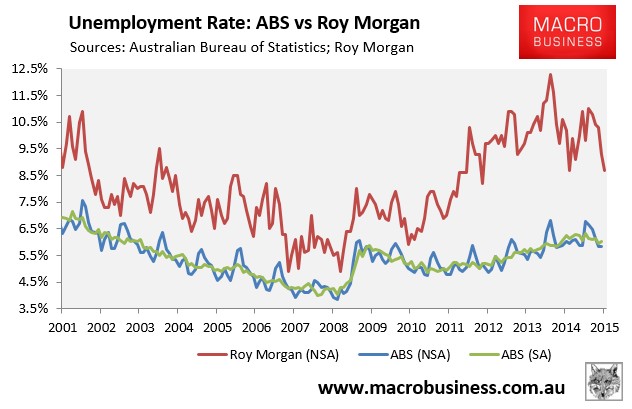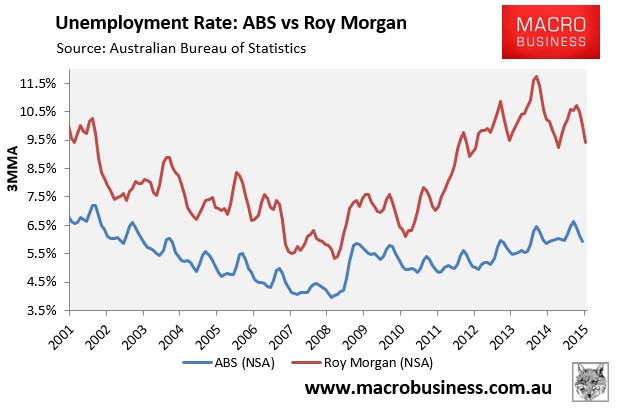Roy Morgan Research (RMR) has released its unemployment estimate for the month of July, which registered a 0.6% fall in the unemployment rate to 8.7% from 9.3% in May. Unemployment was also down 1.5% over the year (see next chart).

Here’s a summary of the release:
- 12,673,000 Australians are in the workforce (up 306,000 since July 2014) – now 11,576,000 Australians are employed (up a large 474,000 since July 2014 – and a new record high);
- 7,900,000 Australians are employed full-time (up a large 547,000 since July 2014 – and a new record high);
- 3,676,000 Australians are employed part-time (down 73,000 since July 2014);
- 1,097,000 Australians are looking for work: 8.7% of the workforce – down 168,000 (or 1.5%) since July 2014;
- 977,000 Australians are under-employed – working part-time and looking for more hours: 7.7% of the workforce – down 102,000 (or 1%) since July 2014;
- 2,074,000 Australians are unemployed or under-employed: 16.4% of the workforce – down 270,000 (down 2.5%) since July 2014 – the lowest since December 2011.
- Despite this month’s decrease the latest Roy Morgan unemployment estimate of 8.7% is still a substantial 2.7% higher than the figure currently quoted by the ABS for June 2015 (6.0%).
According to Gary Morgan:
Australian employment has increased to a new record in July of 11,576,000 (up a large 474,000 since July 2014). The strong rise in employment has been led by a large increase in full-time employment over the past year to a record high of 7,900,000 (up 547,000) while part-time employment has fallen slightly over the same time period to 3,676,000 (down 73,000) according to today’s Roy Morgan July employment estimates.
“The strong rise in Australian employment over the past year has also led to a drop in unemployment – now 8.7% (down 1.5% from a year ago) and the unemployment rate is now down for the fifth consecutive month since reaching a recent high of 11.0% in February 2015. Australia’s under-employment rate of 7.7% is down 1.0% from a year ago.
“Today’s estimates mean total Australian unemployment and under-employment has fallen to 2.07 million (16.4% of the workforce) – the lowest level of total Australian unemployment and under-employment since December 2011. However, despite these figures moving in the right direction, Australian unemployment and under-employment has now been above 2 million Australians for 44 straight months – more than 3 ½ years.
As explained each month, RMR measures employment differently from the ABS:
According to the ABS definition, a person who has worked for one hour or more for payment or someone who has worked without pay in a family business, is considered employed regardless of whether they consider themselves employed or not.
The ABS definition also details that if a respondent is not actively looking for work (ie: applying for work, answering job advertisements, being registered with Centre-link or tendering for work), they are not considered to be unemployed.
The Roy Morgan survey, in contrast, defines any respondent who is not employed full or part-time and who is looking for paid employment as being unemployed…
Since Roy Morgan uses a broader definition of unemployment than the ABS, it necessarily reports a higher unemployment figure. In addition, Roy Morgan’s measure tends to be far more volatile, owing to the fact that it draws on a smaller sample than the ABS and is not seasonally adjusted.
The difference between the ABS unemployment rate (5.8% NSA as at June) and the unofficial RMR measure is now 2.9% (see next chart).

The Sydney/Melbourne housing bubbles are obviously doing their job of supporting employment. This is expected to run for a while yet, so could see unemployment continue to trend lower in the immediate term.
However, the housing construction boom is unsustainable and is likely to top-out sometime early next year, just as the unwind of mining investment accelerates and the local car industry shutters.
In this regard, I view the ongoing recent improvement in labour market conditions as a cyclical improvement within a deteriorating medium-term situation.
2015 was never the problem for Australia’s labour market. It is 2016 and 2017 that are the concern, as the economy faces the triple threat of falling mining-related employment; falling housing-related employment; and falling manufacturing (car industry) employment.

